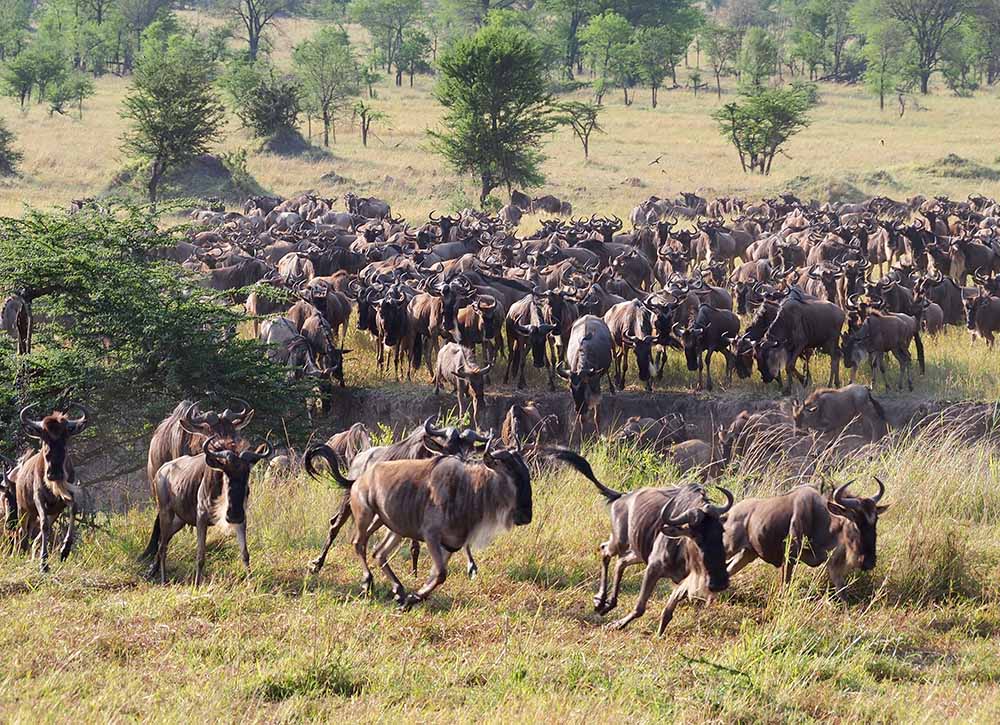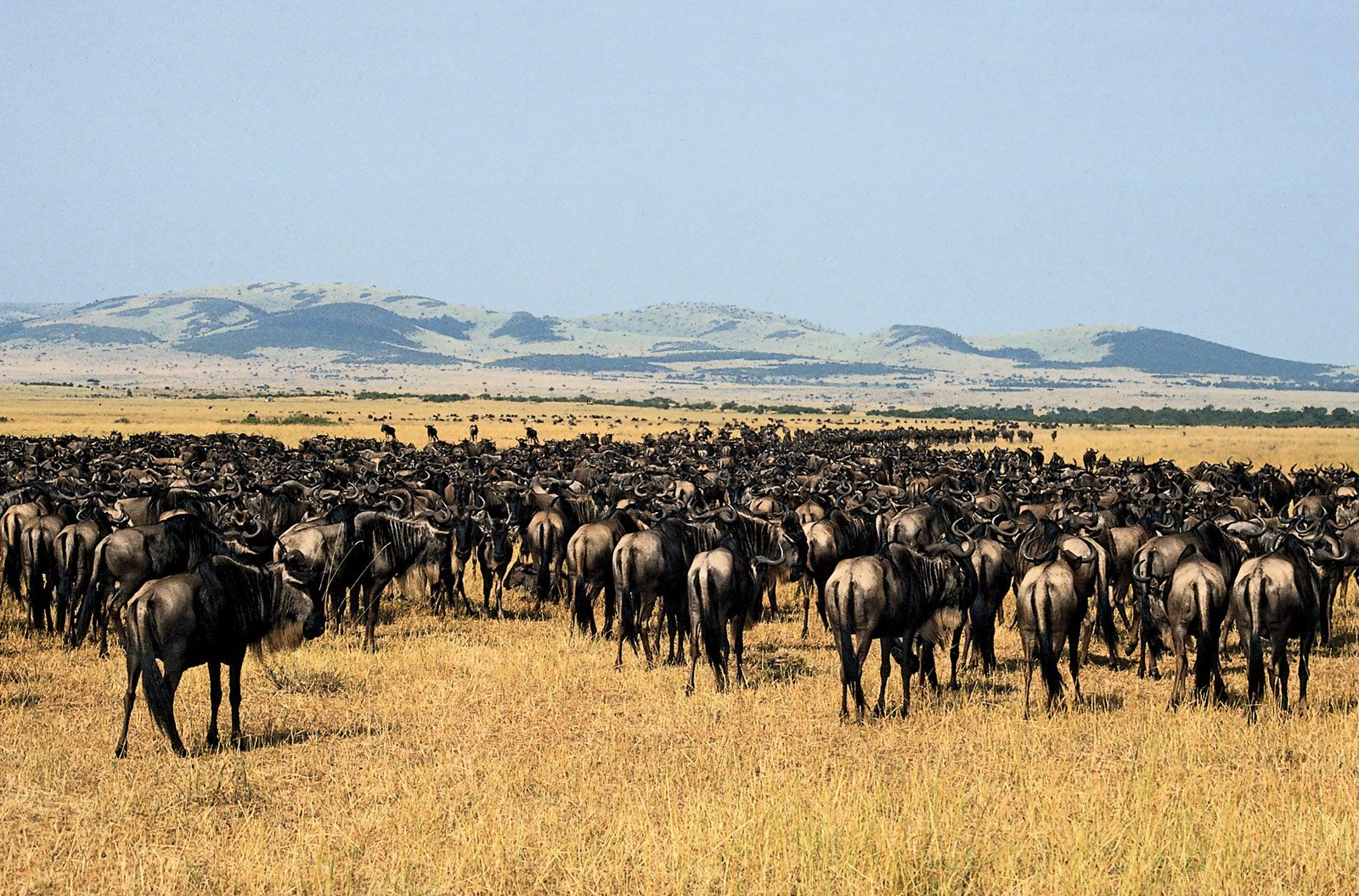When can you see the Great wildebeest migration? The mara is renowned for having an enormous diversity of animals. Over 5 million animals are thought to live in this 1510 square kilometre region of land. The density of wildlife per square mile in the Masai Mara is far higher than that of the Serengeti, despite the latter being 13 times larger. This indicates that, literally, there is wildlife everywhere you turn. Staying in a modest tented Kenya safari camp in mara implies, that wildlife get to move around freely in the vicinity and you sometime may spot a rhino just outside your tent.

The bulk of the animals in the mara are grazers, including as gazelles, antelopes, buffalos, zebras, and elephants. Because of their enormous population, big cat predators like lions, cheetahs, leopards, hyenas, and jackals are able to sustain a higher number of them. Other than the mara, no else in Africa offers more than four prides of lions in a one day. There are occasions when the prides are over 20 members strong. While rhinos are scarce, they may be spotted with minimal effort, and leopards are easier to spot. A reasonably priced budget Kenya safari in Masai Mara may show you more than twenty-five lions and a few leopards.
In comparison to Tanzania’s Serengeti, which is right next door, you are more likely to witness a cheetah sprint or a lion chase in the Masai Mara. Your game drives are rich in wildlife since so many animals are concentrated in a short region. It is guaranteed that you will witness all five of the big five animals in the mara in one day: the lion, buffalo, leopard, elephant, and rhino. The vulture, marabou stork, spotted hyena, wildebeest, and common warthog are among the common ugly five. The big five, along with several additional creatures like giraffes, zebras, Thompson gazelles, hippos, hyenas, jackals, topis, waterbucks, grants gazelles, elands, crocodiles, aardvarks, and many more, would be extremely unlucky to miss on a budget kenya safari in the Masai Mara.
Add the Great Wildebeest Migration, in which over 1.5 million animals travel 300 kilometres in a circle from Tanzania to Kenya, to the mix, as if that weren’t enough. In Kenya, this event takes place from July to October. The bulk of the group, approximately 1.1 million wildebeests, are part of the migration. The approximately 250,000 zebras that follow closely behind them are followed by gazelles. The vast wildebeest migratory route is cyclic in a clockwise direction. The Ngorongoro plains are where the wildebeests begin their journey immediately after the February breeding season. Over 250,000 calves are born in the course of the one-month breeding season. These calves can outrun a leopard in less than an hour because they are born to run.
The mother’s coat is black and grey, while the calves’ coat is brown. Because of this, they stand out and are incredibly colourful among the Ngorongoro and Serengeti’s verdant plains. Regretfully, it also draws the greatest number of predators, including hyenas, lions, cheetahs, and leopards. Before the animals can outpace them and migrate north, there is a feeding frenzy. Although the senseless death of young animals may appear disastrous, it is actually nature’s method of maintaining equilibrium in the populations of these plains’ lawnmowers. The herds move into the Seronera section of Serengeti as they trek north-eastwards towards Masai mara national reserve. By July, they are moving into the mara, where they will spend three to four months feeding and migrating until the vast herds return to the Serengeti.
Every river they cross gives the large cats on the other side of the riverbank a chance. Predators like them will wait for the beasts to cross for days in a welcoming committee. The ultimate kenya safari experience is the Mara River Crossing, when thousands of hesitant wildebeests dramatically flood into the swelling river.
The driver will take you to the Mara River crossing so you may become a member of the predators welcoming committee. In front of your eyes, thousands of wildebeests compete for the frontage of the river in this dramatic scene during high midday. They will bleat for hours on end, but none of them will want to be the first to jump.

The Mara River is rushing and inundated below the steep barrier; several small rock islands appear to float in the surging river. But sadly! These are not islands, but rather 18-foot Nile crocodiles, ready to savage any unfortunate human. The risks involved in crossing the Mara River are so great that the wildebeests will steadfastly resist for several hours before eventually having to jump.
The strain on the now nearly monolithic block of grey wildebeest and zebra brute continues to be increased by new arrivals at the back of the herd. At the riverbed, they jostle and wriggle until the pressure on the leaders becomes unbearable.
The mass of wildebeest bodies is tumbling, sliding, and leaping into the river like a dam wall breached by the action of a single insane person who dares to jump into the water. They will leap ten feet into the air to land in the water with a loud splash in an attempt to divert the crocodiles. Occasionally, they may land on each others backs, breaking their spines and extremities in the process. It’s chaos.
There’s so much mayhem during the stampede of wildebeest crossing the Mara River that people on the other side can hear the water splashing. Swimming as quickly as they can to the other bank, thousands upon thousands of individuals jump into the river. When the zebra and wildebeest begin to swim, crocodiles begin to float around their margins.
The majority get it across, only to be met by lions and leopards when they get there. A handful are caught and submerged. Being the newest comers to a wildebeest migration certainly does not pay off. Many animals die here until it’s your turn to take one for the team and it’s curtains, but an even larger number survive to return a year later, knowing that their sheer numbers will ensure their survival on the next exodus! Make sure not to miss the Mara River Crossing if you are going on a three-day shared budget Masai Mara safari with a group or by yourself.


